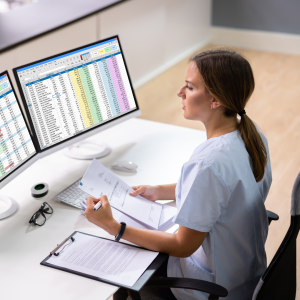Accuracy and efficiency in billing compliance, revenue integrity, and health information management (HIM)/coding processes have never been more critical. As healthcare professionals navigate the industry’s complexities, more organizations are championing the cause of automating traditionally manual billing audit processes.
At the end of the day, it’s a given that manual processes are no longer best serving the audit process. The mounting amount of payor regulations and scrutiny, combined with complex claim data require a risk-based, and automated approach.
The Need for Automation in Healthcare Billing Audits:
Historically, healthcare billing audits have been resource-intensive and prone to human error. The intricate nature of billing compliance, revenue integrity, and coding demands meticulous attention to detail, making it susceptible to oversights and discrepancies.
The top 40 largest U.S. health systems average 54 hospitals per system, and bill to a wide mix of government and commercial insurance plans. Private and self-pay represent the largest payor group for U.S. hospitals with net patient revenue of nearly $759 billion, or 68.9% of the average payor mix.
In 2023, commercial payors were in the headlines for driving reimbursement issues in the industry. MDaudit data for 2023 shows commercial payors denied dollar per initial claim in the professional setting, increased by 30%, 2% in the outpatient setting, and 5% in the inpatient setting vs 2022.
Automating audit processes is a way to help locate the proverbial “needle in the haystack” by identifying the highest billing risk patterns and mitigating risk while maximizing revenue. This change brings both challenges and gains to navigate.
Automation and Technology Integration
The automation of traditionally manual billing audit processes emerges as a pivotal advancement during a challenging time for the industry. By enhancing accuracy, streamlining processes, providing real-time compliance monitoring, and leveraging the power of data analytics, new technologies are empowering billing compliance, revenue integrity, and HIM/coding professionals to drive meaningful outcomes.
Perhaps the two most-talked-about aspects of technology and automation, artificial intelligence (AI) and benchmarking capabilities take center stage in automating the audit process (both prospective and retrospective).
What capabilities and functions should you look for in these two areas of technology?
Enhanced Accuracy: Manual billing audits are inherently susceptible to human error, which can lead to compliance issues, revenue loss, and compromised patient care. Automated solutions leverage advanced algorithms and artificial intelligence to ensure a level of accuracy unattainable through traditional methods. By eliminating the margin for error with enhanced accuracy, healthcare professionals can have confidence in the integrity of their billing processes.
Streamlined Processes: Manual audits often entail time-consuming and repetitive tasks, diverting valuable resources from more strategic initiatives. Automation streamlines these processes, allowing billing compliance, revenue integrity, and coding professionals to focus on higher-value activities. This not only enhances operational efficiency but also contributes to a healthier bottom line for healthcare organizations.
Real-time Compliance Monitoring: In an ever-evolving regulatory landscape, staying abreast of compliance requirements is paramount. Automated solutions provide real-time monitoring of billing activities, ensuring that healthcare settings remain compliant with the latest regulations. This proactive approach not only mitigates the risk of audits and penalties but also fosters a culture of continuous improvement within healthcare organizations.
Data Analytic Capabilities: Automation enables the collection and analysis of vast amounts of data, offering insights that were previously inaccessible. A technology’s data analytic capabilities can empower healthcare professionals with actionable intelligence, facilitating informed decision-making. From identifying revenue leakage to optimizing coding practices, the strategic use of data enhances the overall financial health of healthcare settings.
Benchmarking: One of the most important facets of a risk-based approach is the ability to benchmark an organization’s data to a variety of different sources. One of the fastest ways to identify habitual overcoding and undercoding is the ability to compare physician billing patterns to others within the same specialties and service lines (both internally and externally). Data analytics and benchmarking will easily unearth those exhibiting billing patterns outside of normative ranges. Benchmarking and automation allow for the optimization of billing, coding, and revenue outcomes.
For those moving to a risk-based, data-driven approach, change can seem overwhelming, but MDaudit is your partner in change management and implementation, supporting your success in the long term.
Whatever technology is implemented, a continuous risk-based monitoring capability is essential for mitigating risk and maximizing reimbursement. This integration of automation is part of MDaudit’s commitment to optimizing billing, coding, and revenue outcomes.









